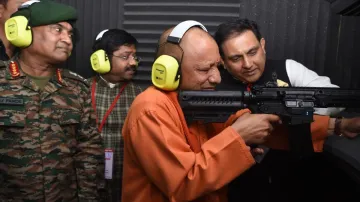Army Chief General Manoj Pande says govt, Army gave significant fillip to defence manufacturing ecosystem
Earlier today, in a landmark achievement for India’s defence sector, two mega facilities to manufacture ammunition and missiles were inaugurated in Uttar Pradesh's Kanpur.

Army Chief General Manoj Pande on Monday visited the Ammunition and Missile Complex in Uttar Pradesh's Kanpur and said that multiple initiatives by the government and the Indian Army have given significant fillip to the defence manufacturing ecosystem and resulted in major contracts being awarded to the Indian defence Industry. The event was attended by government functionaries, industry leaders and dignitaries.
The Chief of Army Staff mentioned that multiple initiatives by the government and the Indian Army to provide an enabling environment in terms of policy provisions, licensing norms, establishment of Defence Industrial Corridors and handholding in terms of trials and testing, have given significant fillip to the defence manufacturing ecosystem and has resulted in major contracts being awarded to the Indian defence Industry.
Army Chief underscored that initiatives to transform the Indian Army into an Aatmanirbhar and future-ready force as regards acquiring new weapon platforms, equipment and systems, is the need to be able to indigenously source or produce all that is necessary to fight, i.e., the ammunition, spares and other maintenance requirements.
"Strategic prudence dictates that indigenous capacities in ammunition production is a crucial factor, in maintaining operational readiness and tempo during conflict", he said.
Indian Army has large ammunition inventory, says Army Chief
He mentioned that the Indian Army has a large ammunition inventory comprising 175 variants of different calibre and type. These range from ammunition for vintage platforms to advanced precision-guided munitions.
Out of these, 134 ammunition variants have already been indigenised through efforts of DRDO, Defence Public Sector Units and Private Industry. However, due to production constraints, capacities and large requirements, for both operational and training needs, there exists a demand versus supply gap, which needs to be met through a diverse indigenous vendor base of private industry.
He acknowledged that manufacturing of ammunition is a high-tech, high-cost venture and mandates significant investment in Research and Development, infrastructure, testing and evaluation facilities, to ensure that stringent standards of safety and performance are met.
"Production and manufacture of ammunition of the desired specification and its sustenance throughout its life span is a complex process, requiring advanced manufacturing techniques and quality control checks, at each stage. This includes checks concerning raw materials, process testing, lot testing, sampling and traceability protocols, to mitigate risk of defects," he said.
He also mentioned that most of the ammunition categories, proposed for manufacturing by the Indian Army also have sufficient export potential.
"With the evolving global security environment, the demand for ammunition is expected to grow manifold. Considering the limited players in the field, worldwide, with expertise in ammunition manufacturing, and our competitive manufacturing cost, the Indian Industry will have a huge advantage. The export potential, according to one estimate, is approximately Rs 16,000 crore. Therefore, to emerge as a global hub for niche technology and innovation in the field of ammunition, it is imperative to maintain the desired quality and global standards", he said.
Defence Industry's participation in ammunition manufacturing encouraged by multiple policy changes
He noted that the participation by the Defence Industry in ammunition manufacturing has been encouraged by multiple policy changes, including interactive RFP formulation in consultation with the industry, broad-banded technical specifications to encourage wider participation and offering of existing infrastructure and ammunition components for trials. He mentioned that the transformative initiative of the Government has begun to show tangible results, and these state-of-the-art facilities for ammunition and missiles being witnessed today are testimony to the indigenous production and supply chain ecosystem, that is taking shape.
He expressed his happiness by informing the gathering that more than 85 per cent of Army's ammunition is now being sourced indigenously. In addition, multiple cases are in advanced stages of fructification. "To further promote this initiative, the Indian Army has carried out a holistic review for a time-bound indigenisation plan of all ammunition currently imported, by onboarding private industry. Accordingly, a well-defined roadmap has been put in place based on the type of ammunition and existing capacities", he said.
He also mentioned that 32 variants of ammunition in twelve categories were identified in Phase One for manufacture by the Indian Industry.
"All cases are likely to fructify in the next one year, as per the envisaged timelines. Approval has been already obtained for five additional ammunition categories to be developed in Phase Two. Simultaneously, make programmes for developing new generation ammunition including the Electronic Fuses currently not held in the inventory, are also being progressed", he said.
He noted that the enthusiasm and intent displayed by our industry, the residual import dependence shall be adequately addressed, in the coming years. The Army Chief underscored that, with India’s established expertise, competitive manufacturing cost and increasing capacities in ammunition production, the nation and armed forces shall soon realise the vision of ‘Make in India, Make for the World’ by becoming net exporters of ammunition.
He urged all to collectively contribute to the aspirations, goals and objectives of a rising India, through the resolve and commitment to Aatmanirbharta.
ALSO READ | Adani unveils South Asia's largest ammunition manufacturing complex in UP, Army chief lauds ‘milestone'